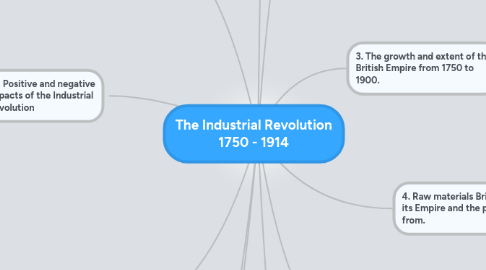
1. 1. Why did the Industrial Revolution begin in Britain?
1.1. Success of overseas colonies
1.1.1. Masses of resources drawn from empires as a result
1.1.1.1. Could produce goods cheaply and sell for huge profit
1.1.1.1.1. Colonies provided new markets for manufactured goods
1.2. Success of the slave trade
1.2.1. Slaves bought in Africa and sold to tobacco and cotton plantations in America
1.2.1.1. Cotton and tobacco was in turn sent back to Britain to be sold
1.3. Changes to energy, machinery, and scale
1.3.1. Human and animal labour replaced by steam
1.3.1.1. Steam followed by gas and electricity
1.3.2. New inventions and techniques that changed the way coal and steel were formed
1.3.3. Many small workshops employing few people turned into large factories employing hundreds of people
1.4. Change to transport
1.4.1. Creation of railways and canals allowed materials to be moved quickly and easily.
2. 7. Population movement during the Industrial Revolution
2.1. People moved from country villages to towns and cities
2.2. Wealthy people emigrated to other countries in the Empire to try and build business (eg Australia) as free settlers
2.3. Other people were forced to move to cities in search for work - agricultural revolution left many people without jobs
3. 8. Changes to the way of life
3.1. With the move to towns and cities living conditions got very crowded and unsanitary
3.1.1. Water was dirty, food was increasingly expensive and poor quality
3.1.1.1. eg. The River Thames was so polluted it could no longer sustain any fish or plant life - yet people still bathed in it and drank from it!
3.1.2. Whole families of up to ten lived in a single room without running water
3.1.2.1. There was often no running water and sewage systems were not invented until the early 1900's.
4. 9. Working conditions
4.1. There were very little safety considerations
4.1.1. Workers were considered an expendable source - it was cheaper to replace a worker than install safety devices
4.2. Children were forced to work from the age of three to help provide food
4.2.1. Children were often used in cotton factories to clean out clogged machines - many lost limbs or their lives in the process
4.3. Women and children preferred as workers as they were paid less and could get into tight spaces in machinery
4.4. Those who fell asleep severely punished if they were lucky enough to escape death by falling into a machine
4.5. 'The Poor Law'
5. 10. Positive and negative impacts of the Industrial Revolution
5.1. Increased use of fossil fuels and increased emission of greenhouse gases - led to smog and air pollution
5.2. Increase in consumption and waste - land fill
5.3. Increased awareness for sustainability
5.4. New technologies
5.5. Population growth
5.6. Water pollution
5.7. Urbanisation
5.8. Industry
5.9. Forest clearing
6. 11. Short-term and long-term impacts of the Industrial Revolution
6.1. Global landscape growth and change
6.2. Transport
6.3. Communication
6.4. Social revolution
7. 2. The agricultural revolution in Britain.
7.1. New machines - seed drilling machine which allowed seeds to be sown quickly
7.2. Invention of mechanical ploughs, reaping machines and threshing machines
7.3. Farm workers became replaced by machines -- had to move to cities for industrial work
7.4. More efficient uses of land
7.5. Inclosure movement - the use of fences and boundaries to divide properties amongst people rather than the use of common land
8. 3. The growth and extent of the British Empire from 1750 to 1900.
8.1. MAP HERE
8.2. By 1900 Britain's empire covered a quarter of the world's land surface
8.3. Two stages - old colonial system and new imperialism
8.3.1. From 1750 - mid 19th C, main reason for empire building was to improve trade. The aim was to set up colonies in the Americas and Asia to provide goods,
8.3.2. Towards end of nineteenth century the empire became popular with the British people. Slavery abolished and colonies began to want self-government. Empire continued to grow into Africa (the 'white man's burden').
9. 4. Raw materials Britain obtained from its Empire and the places they came from.
9.1. Wool from Australia
9.2. Sugar from Jamaica
9.3. Cotton and tea from India
10. 5. Key inventors and their inventions - how did they affect transport and manufacturing?
10.1. Jethro Tull invents mechanical seed drill c.1701
10.2. Newcomen engine invented 1710-12
10.3. Britain's first canal 1757
10.4. James Hargreaves invents spinning jenny 1764
10.5. James Watt condensing steam engine 1763-75
10.6. World's first railway line in Britain 1830
11. 6. How industrialisation contributed to the development of Britain and Australia
11.1. Coal, textiles, transport
11.2. Mining increased
11.2.1. Employment increased
11.2.1.1. Technology improved production
11.3. Textiles -- Wool became a boom industry in Australia with the development of the Merino breed
11.3.1. Factory system and new machines made the production of textiles quicker, more efficient

